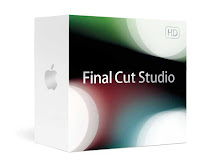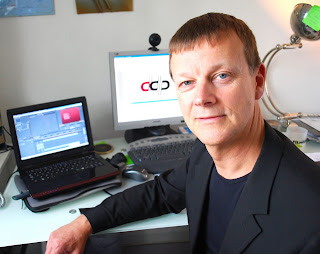An awful lot goes in to the making of a high-quality lens – but not arsenic, at least not since the European Union banned it from being used in glass (imagine if a sweet little infant were to suck on glass made with arsenic. The horror! The poor unfortunate would probably be dead within, oh…, a 100 years or so….).
Unfortunately, this effort from the EU to save us from ourselves makes life more difficult for lens manufacturers, as I found out on a visit to Cooke Optics' factory in Leicester.
The initial glass blocks come in from all over the world (Cooke uses more than 100 types of glass – each has a different colour and refraction index), and are ground and polished with incredible precision.
The lenses are then tested by eye, and rejected if there are any imperfections or bubbles. Unfortunately, these tiny bubbles don't show up until the elements are polished, which wastes a lot of hard work. This happens more often now, due to the EU ruling, because nothing matches arsenic at reducing the bubbles, which means: "We can't buy glass to the standard we reject it to," explained Les Zellan, Cooke's chairman.
Cooke makes very high-end lenses for 35mm film and digital production, a set of which can cost £100,000, but demand outstrips supply, as production takes time and requires great skill.
The Daily Grind
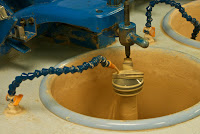
Glass initially goes to the grinding shop, where it is taken to about 20 microns of the eventual shape.
Then they polish it.
This can be done on wonderful leather-belt driven machines, which do the traditional spherical polishing. It takes longer, and is more labour intensive, but operators can do several elements at a time. Incredibly, the skilled operators can be more accurate than computer controlled polishers. They can fit up to 20 elements on a block (if they are small enough), which can also make them faster, even though it takes about eight hours per block (however many elements are on it).
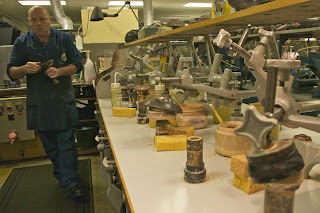 It requires great skill as each type of glass has its own idiosyncrasies and a slight temperature difference between the centre and the edge of a glass element can cause the glass to crack at a later stage in the process, when even more has been devoted to it.
It requires great skill as each type of glass has its own idiosyncrasies and a slight temperature difference between the centre and the edge of a glass element can cause the glass to crack at a later stage in the process, when even more has been devoted to it."It takes about five years to train a polisher, but for the first three years you don't even know if they'll be any good, so it's a big investment," said Zellan, who bought the company in 1998 (it had spent many years as part of the Rank group).
The computerised machines are faster, but only do one element at a time (they can do one in about 30 minutes).
On reflection
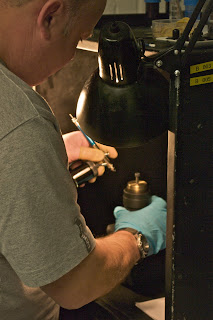
For most other manufacturers, the next part of the process is edging (blacking the edges to control reflections - pictured right), but Cooke goes to coating next – because it can, as its coatings are "really, really hard" and won't be damaged by edging.
Coating is done in large vacuum chambers, using a vapour of various metals. An uncoated element reflects 4% of the light for each surface, and as a modern lens can have 15 to 20 elements, this would considerably reduce the amount of light getting through.
Before coating, you might have an F4 lens with a transmission factor of T11 (indeed, that is why T stops came into being, as that was what the film labs cared about). With modern coatings, you lose less than 0.1% light per surface, which means that Cooke can build an F1.9 lens at T2.
Most manufacturers do multi-layer coating one layer at a time, but Cooke does all the layers at once.
To template each lens element, Cooke has about 4,000 master gauges (each of which is worth about £5,000 – about £20m in total), to which each new element is matched to make sure it is perfect. For every master gauge, there is a set of tooling.
Many of Cooke's machines are at least a century old (it has been manufacturing lenses in Leicester since 1894), although it also has computerised versions (designed especially for it) that were installed in 2008 (although they are unlikely to last so long).
"The lenses we put out are extremely consistent. There is lots of quality control checking along the way, so that a lens from today is virtually the exact same as one from ten years ago," he claimed.
It takes about three months for the whole process, from receiving the glass until the lenses are ready for delivery.
This could lead to very long delivery times, so Cooke sacrifices efficiency to make lenses in very small batches each month, so that it can deliver an order in one shipment.
An order for S4/i lenses can take one to four months. He hopes that the new Panchros will be a bit faster, as they are easier to put together), but the 5/i lenses are more complicated. "Every stop [wider] adds about a factor of eight times in terms of tolerances, so speed kills."
Two new lines
Cooke has about 80 staff, including a handful of designers (one woman was an original "computer" who did all the complex computations manually, although she now has a computer hardware to help her).
With so few people, it makes it even more impressive that they have developed two new ranges of prime lenses this year (adding to the S4/i line it already had). This was only possible because it has invested in new technology, and it now has eight computer-controlled machines running 24-hours-a-day five days a week.
"We've never been able to keep up with demand for our product," admits Zellan.
Traditional spherical lenses are relatively straightforward, but aspherical elements are a lot more difficult to polish, as they require extremely precise measurement.
It has a small network of grinding, polishing and measuring machines that talk to each other and make sure that the grinding and polishing is exact.
Several of the S4 lenses and many of the 5/i lenses have aspheric elements (which generally allows the lenses to be smaller and to use less glass).
The Panchro lenses cost less than half the price of the S4/i lenses, although it isn't a cheap lens. Indeed, it is essentially an S4 but with one stop less light. "We didn’t cut corners on the quality. What enabled us to cut the price is taking a stop out of it." At T4, it will match the S4 exactly.
Zellan doesn't know how long it takes to build a lens. "It takes as long as it takes to get right. It might take a few days or a week, depending on how long it takes to make so they are consistent."
Once the lens is built, it is taken apart again, to clean it, and rebuilt. Every lens is then hand-calibrated for iris and distance.
A 4K sensor (as on the Red One) only needs to be able to resolve 32 line pairs on a test chart, but the Cooke lenses are claimed to be able to resolve more than 200 line pairs (the equivalent of 18K or even 20K on a digital sensor – film is typically about 6-8K).
Besides its three prime ranges, there is also the CXX 15-40mm lens, which he claims is the "only fast, lightweight zoom" T2.0 lens.
The Cooke look
Its lenses are renowned for having a warm, attractive look. "The Cooke look is real. It tends to be a much more dimensional look than our competitors. The lenses are also warm, and flatter the subject," he said.
The designers aim for high resolution, but lower contrast, to give better results on film (or sensor) rather than in the viewfinder.
"Some of this is counter-intuitive. The reason our lenses look warm is because we pay a lot of attention to the blues and greens, which is what both film and chips are most sensitive to."
He says that Zeiss tends to accentuate reds and greens, which can make its lenses look cold.
"It's a combination of glass choices (all of which have different colour characteristics) and, to a much less extent, to the coatings."
Cinematographers who like the Cooke look tend to stick with it "Lenses are the paint brushes the cinematographers use," he explained, so aesthetics are very important.
This is why its lenses are used on many popular TV shows, such as House, CSI: New York, Bones, Grey’s Anatomy, 30 Rock and Burn Notice, as well as lots of movies, such as the Harry Potter series, The Bourne Ultimatum and Transformers.
However, it also helps that the basic maintenance needed for a Cooke lens is about an hour compared, he claimed, to about a day for its rivals. "This allows a rental house to get a lens back one night and put it back out the next day."
/i technology
Cooke, which manufactured the first ever zoom lens in 1936, has been a leader in putting electronics in the lenses. Its /i technology is a metadata system that it introduced in 2005, although it is only now really catching on. All of its lenses are smart lenses, so that they can talk to the cameras and other equipment on set.
The Red One adopted /i, although it only got that working fully late in 2009, but it can now read and record it. Other /i cameras include the Sony F35, Arri cameras and the new Aaton Penelope film camera – "It's quite a bit of work for them, because they have to put in contacts for the lens. But everybody now understands the need for metadata in post," he said. It is widely used in post production, such as by The Foundry for its Nuke system.
The lenses typically have two sets of connectors – four contacts on the lens mount and an external connector (although that is not on the Panchro).
As lenses become faster, everything about their construction becomes more difficult, including calibrating their scales, so Cooke had to build a new calibration area with computer controlled equipment for the 5/i range.
The scales are never pre-engraved on the metalwork, because they need to be exact for each lens, all of which have subtle differences. The /i technology is also set for each lens.
Zellan at IBC: with the new 5/i and Panchro lenses
New line for cinemaThe PL-mounted Panchro By Cooke lenses are a modern redesign of the fast Cooke Panchro lenses that were much favoured in Hollywood from the 1930s onwards.
The Panchro is small, lightweight, and sacrifices one stop of light, at T2.8, compared with T2.0 for the S4. "Traditionally lenses were best used two stops down from the widest stop, 2.8 or 4.0, but the S4 was one of the first lenses designed to be used wide open, and today's lenses are all designed to be used at their fastest speeds," explained Zellan. However, "you only work at those speeds if you absolutely have to, because depth of field is so limited. Most shooting is probably done at F4."
The reduced size, weight and true focal length markings also make the Panchro range more suitable for 3D stereoscopic productions. It is available in 18mm, 25mm, 32mm, 50mm, 75mm and 100mm lengths.
Cooke sold out its first production run of Panchros, just before IBC, in just 90 minutes, and is now back-ordered six to nine months ahead.
The even newer 5/i lenses are a stop faster than the S4, at T1.4, covering: 18mm, 25mm, 32mm, 40mm, 50mm, 65mm, 75mm, 100mm, and 135mm.
It is the first set of lenses with illuminated scales. "This means the end of the assistant standing with a flashlight in their mouth in the dark," said Zellan. This is important as the speed of the lens makes them suitable for night filming. The lenses cost about 20-25% more than the S4.
By David Fox


















